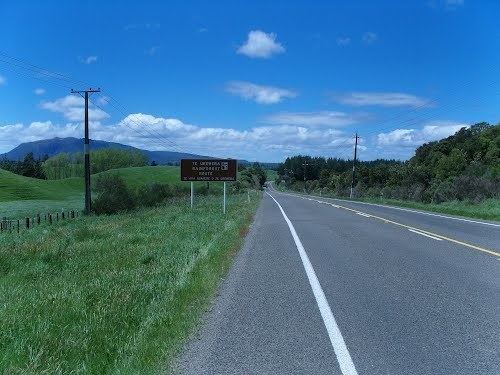Country New Zealand Territorial authority | Region Bay of Plenty | |
 | ||
Galatea is a settlement in the Whakatane district in the Bay of Plenty region of the North Island of New Zealand.
Contents
Map of Galatea 3079, New Zealand
The forested hills and mountains of the Ikawhenua Range and in particular Mount Tawhiuau stand guard on the eastern flank of the Galatea Plains or Basin, an area surrounding the village. To the west, and over the Rangitaiki River stretch the 120,000 acres (490 km2) of the Kaingaroa Forest.
Geography
The Southern boundary of the Galatea Plains is the Whirinaki River which descends from The Ureweras and joins the Rangitaiki River below the township of Murupara. A few miles downstream and on the Western side of this trout filled river, Fort Galatea was built, where, from their lofty lookout, the constabularies living there were able to survey the tracks used by the many Māori who passed by on their way from or to the coast near Whakatane.
To the North the Ikawhenuas lower and gradually close in to reach the right hand bank of the Rangitaiki River, leaving only enough room for an access road from the valley over "Snake Hill" to the Rangitaiki Plains.
History
The coastal area of the Bay of Plenty has been occupied by various tribes of Māori arriving in canoes from the islands of Polynesia. As more canoes arrived, the newcomers either fitted in with the peaceful residents or overcame them. They fished when the season was right, then moved inland to trap pigeons, gather fernroots, and catch eels. At these times they reached Waiohau, Galatea, Murupara and Te Whaiti.
When visits of European trading ships became more common, the Galatea Maori would travel down the river with goods to barter. Flax was their main commodity and axes, spades, hoes and later, guns and clothing were given in return. These people were Ngāti Manawa and their neighbours in the adjoining Urewera forested hills were the Ngāi Tūhoe, or "Children of the Mist", who often raided the Ngāti Manawa and on occasion drove them out of the area.
Pōmare, chief of the Ngāpuhi from Northland was in the habit of travelling south to fight with the Bay of Plenty tribes and after attacking all the pā on the plains, chased the Tūhoe back into the Urewera hills. He returned home with his canoes loaded with spoils and heads of the vanquished, only to return a year later The Ngāti Manawa were relieved to see the Ngāpuhi disappear up the Horomanga River to meet up with Pōmare's party who travelled up the Waimana River into the mountainous Urewera lands.
A principal chief of Tūhoe sent a messenger to Pōmare asking for a meeting at which the threat of war between the tribes ceased and this led to continuing peace between Ngāpuhi and Tūhoe.
The Pai Mārire religion started in Taranaki and was introduced to the Bay of Plenty in 1865 by two of its prophets who met the Tūhoe, Ngāti Manawa and Ngāti Whare tribes with the object of explaining the "new religion". Some accepted and were initiated around the head of Captain P.W.J. Lloyd who had been killed in Taranaki. In Opotiki, the Rev. Carl Völkner, a much loved missionary was murdered by Hauhau, and later a half-caste interpreter, James Fulloon was murdered at Whakatane. Open hostility to "pākehā" was shown over a wide area, and killings occurred on both sides.
This is where Fort Galatea came into use. HMS Galatea at that time was visiting the country under the command of Prince Alfred, Duke of Edinburgh. and it is from this ship that the name was derived. Soldiers were stationed at the Fort in readiness to march into the Urewera forests to fight the Hauhau, and with them a renegade by the name of Te Kooti who had been captured after a battle in the Poverty Bay area. He was transported as a prisoner to the Chatham Islands when he soon became the leader of the prisoners. During a riot, they escaped, seized a schooner and reached the mainland where they continued the war against the pākehā. Te Kooti was ruthless and in complete control of the Hauhau, even though he was not one of them, but was a prophet and leader of what was to become the Ringatū religion.
